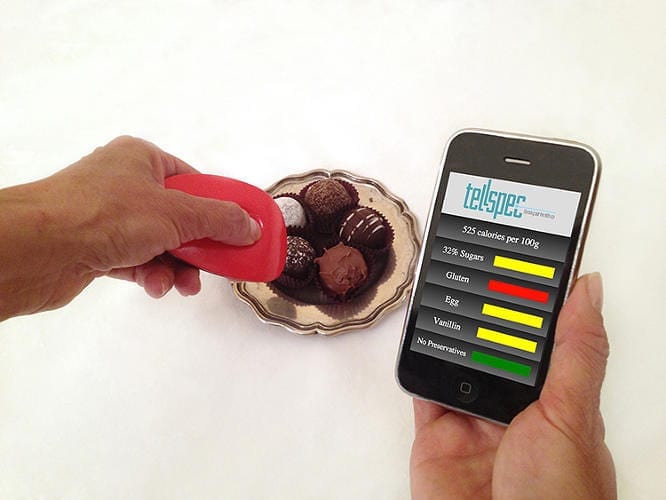
The Indiegogo hit Tellspec scanner shoots a laser at your food and counts the calories and nutritional data. But is it just vaporware? We tried one out.
If there’s one thing true about the International Consumer Electronics Show (CES) in Las Vegas, it’s that there’s no shortage of people who think they have a groundbreaking idea. With a mind-numbing array of wearable technology, bendable screens, and “Internet of things”-type devices at the show this year, it can be debated just how much any one product truly breaks ground.
The TellSpec laser scanner appears, at least in its demo form, to have potential. The device is a raman spectrometer that uses an algorithm to calculate what’s in your food. You point the laser at a potato chip for instance, and the accompanying app on your smartphone gives you a read-out of the ingredients.
TellSpec founder Isabel Hoffman gave me a demonstration of the device in action during CES. She turned on a prototype, which isn’t yet as slim or pretty as the hoped-for final product, and pointed the laser at chips, bread, and various snack foods.
I, not a particularly big fan of processed foods, was anxious to see if the device could easily point out the man-made goo that some companies put in their products. It did this in less than 30 seconds with one chip-like snack food she scanned. After pointing her laser, a list of ingredients popped up on the TellSpec app.
Seeing that something called “tartarzine” was listed, I was able to click through to a detailed wiki-like page explaining that this is in fact Yellow No. 5. Based on some of the information the app provided me on tartarzine, I’m leaning away from eating it in the future.
There were a few caveats. Although the device can point out allergens, she says it’s not as accurate as it may someday be, and isn’t a cure all for them.
“Right now the algorithm works very well tabulating carbohydrates, proteins, fats, and calories,” she said. “But we are very concerned with the allergies that we may not track down enough parts per million yet.”
Hoffman says when the device is released there will be an allergy disclaimer that comes along with it. The team hopes to add in more functionality over time in that area.
The Latest on: Raman spectrometer
[google_news title=”” keyword=”Raman spectrometer” num_posts=”10″ blurb_length=”0″ show_thumb=”left”]
via Google News
The Latest on: Raman spectrometer
- Laser Technique Accurately Distinguishes Elephant and Mammoth Ivory, Impacting Ivory Tradeon April 28, 2024 at 11:10 pm
It could potentially help us detect even finer distinctions such as the age of the ivory or specific environmental conditions where the elephants or mammoths lived.There are also other non-destructive ...
- New laser tech using Raman spectroscopy detects illegal elephant ivoryon April 25, 2024 at 11:23 am
Now, scientists have devised a way to detect a distinction between illegal elephant ivory and legal mammoth tusk ivory. They developed a laser-based approach employing Raman spectroscopy to ...
- MIT Technology Reviewon April 23, 2024 at 2:00 pm
Electrical engineer Nili Persits, PhD ’24, has developed low-cost Raman spectroscopy systems that allow instant chemical analysis.
- Shining Bright: Raman Spectroscopy Market Surpasses $1.1 Billion by 2028on April 23, 2024 at 1:47 am
The Raman Spectroscopy Market is expected to grow from USD 0.8 billion to USD 1.1 billion between 2023 and 2028, at a 7.0% CAGR.
- Nanoparticle fix opens up tricky technique to forensic applicationson April 16, 2024 at 5:01 pm
A technique called surface-enhanced Raman spectroscopy can detect tiny quantities of compounds in solution, but has been difficult to use for quantitative analysis. A digital approach involving ...
- Raman Spectroscopy in Nanomedicineon April 10, 2024 at 5:00 pm
Raman spectroscopy is a branch of vibration spectroscopy that is capable of probing the chemical composition of materials. Recent advances in Raman microscopy have significantly added to the range ...
- Novel UV broadband spectrometer revolutionizes air pollutant analysison April 9, 2024 at 5:00 pm
Novel UV broadband spectrometer revolutionizes air pollutant analysis Date: April 10, 2024 Source: Graz University of Technology Summary: A research team has developed a broadband UV dual-comb ...
- KAIST and MIT develop compact Raman platformon April 9, 2024 at 5:00 pm
"Dispersive Raman spectroscopy requires a bulky spectrometer, which limits its field applicability," commented the project. "Therefore, there has been a tremendous need to develop a portable and ...
- Team develops portable swept-source Raman spectrometer for chemical and biomedical applicationson April 4, 2024 at 2:34 pm
The discovery laid the foundation for Raman spectroscopy, a technique that takes advantage of these energy changes to create a unique fingerprint of the molecular structure of the material.
- Portable swept-source Raman spectrometer for chemical and biomedical applicationson April 4, 2024 at 10:17 am
SS-Raman spectroscopy employs a swept-source laser, a narrow-bandwidth bandpass filter (BPF), and a highly sensitive point photoreceiver for sample identification. These components enable the ...
via Bing News









